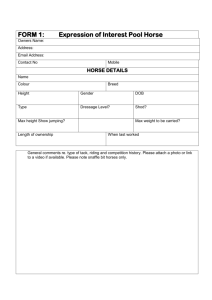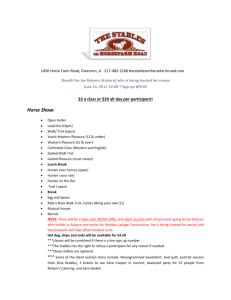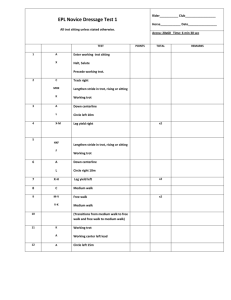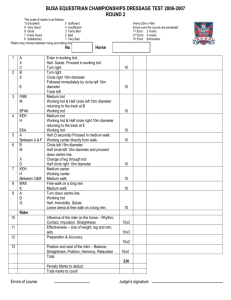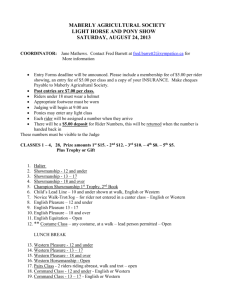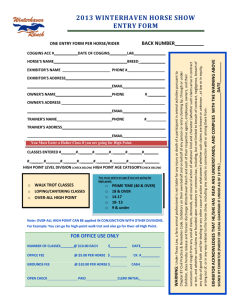GENERAL RULES FRIESIAN HORSES SUITABILITY
advertisement
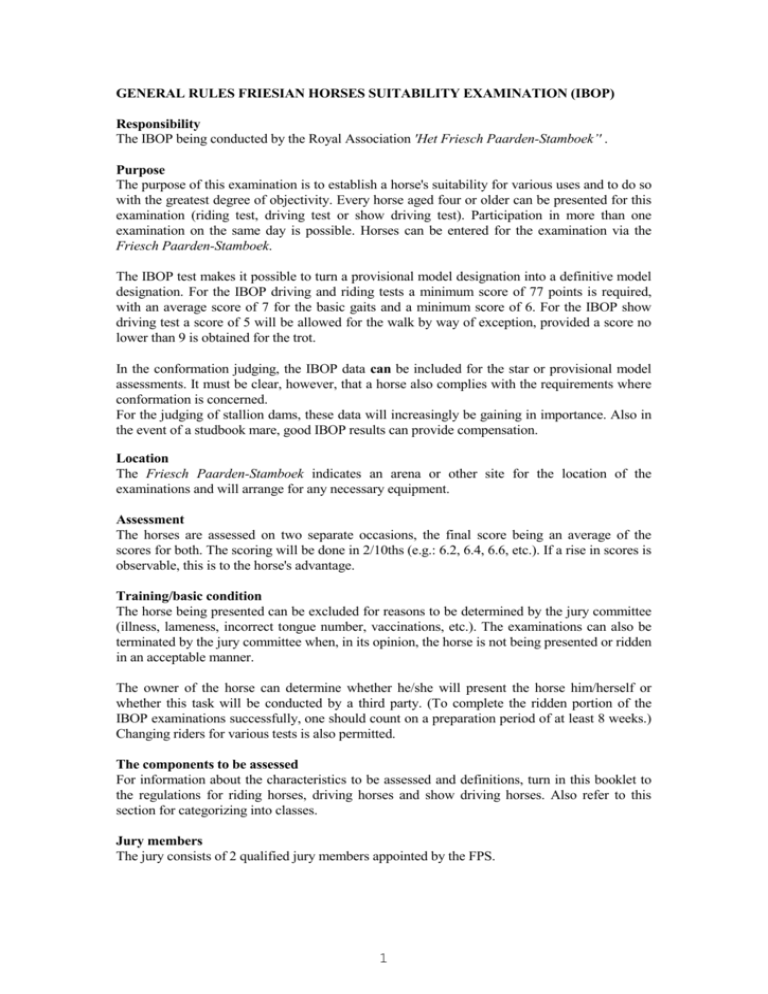
GENERAL RULES FRIESIAN HORSES SUITABILITY EXAMINATION (IBOP) Responsibility The IBOP being conducted by the Royal Association 'Het Friesch Paarden-Stamboek’' . Purpose The purpose of this examination is to establish a horse's suitability for various uses and to do so with the greatest degree of objectivity. Every horse aged four or older can be presented for this examination (riding test, driving test or show driving test). Participation in more than one examination on the same day is possible. Horses can be entered for the examination via the Friesch Paarden-Stamboek. The IBOP test makes it possible to turn a provisional model designation into a definitive model designation. For the IBOP driving and riding tests a minimum score of 77 points is required, with an average score of 7 for the basic gaits and a minimum score of 6. For the IBOP show driving test a score of 5 will be allowed for the walk by way of exception, provided a score no lower than 9 is obtained for the trot. In the conformation judging, the IBOP data can be included for the star or provisional model assessments. It must be clear, however, that a horse also complies with the requirements where conformation is concerned. For the judging of stallion dams, these data will increasingly be gaining in importance. Also in the event of a studbook mare, good IBOP results can provide compensation. Location The Friesch Paarden-Stamboek indicates an arena or other site for the location of the examinations and will arrange for any necessary equipment. Assessment The horses are assessed on two separate occasions, the final score being an average of the scores for both. The scoring will be done in 2/10ths (e.g.: 6.2, 6.4, 6.6, etc.). If a rise in scores is observable, this is to the horse's advantage. Training/basic condition The horse being presented can be excluded for reasons to be determined by the jury committee (illness, lameness, incorrect tongue number, vaccinations, etc.). The examinations can also be terminated by the jury committee when, in its opinion, the horse is not being presented or ridden in an acceptable manner. The owner of the horse can determine whether he/she will present the horse him/herself or whether this task will be conducted by a third party. (To complete the ridden portion of the IBOP examinations successfully, one should count on a preparation period of at least 8 weeks.) Changing riders for various tests is also permitted. The components to be assessed For information about the characteristics to be assessed and definitions, turn in this booklet to the regulations for riding horses, driving horses and show driving horses. Also refer to this section for categorizing into classes. Jury members The jury consists of 2 qualified jury members appointed by the FPS. 1 Results of the examinations The jury committee will record its findings on a certificate. In addition to the scores, the committee shall also provide a brief explanation and any other significant information if necessary. Finally, the jury committee shall authorize the certificate by means of signing and dating it. The results are communicated to the interested parties at the conclusion of the examinations. The certificate is sent to the interested parties once it has been prepared. The results will also be published in Phryso and be recorded in the studbook certificate. KEYS TO SCORES All examinations are scored on the basis of scores from 1 to 10. The scores have the following meanings: 0 not performed 1 very poor 2 poor 3 fairly poor 4 less than unsatisfactory 5 unsatisfactory 6 satisfactory 7 more than satisfactory 8 good 9 very good 10 exemplary 2 EXAMINATION REGULATIONS FOR RIDING HORSES Conditions Dimensions of ring: at least 20 x 40 meters no larger than 25 x 50 meters Bridling: Bridle and snaffle with drop nose band, English or combined nose band; single thick bit (metal or rubber); and single or double reins. The use of martingales and balancing reins, bandages, boots and brushing boots is not permitted. The use of spurs and whip is permitted. The rider should be dressed in formal riding attire with a riding hat. [For a detailed description, the reader is referred to the General Criteria for Competitive Sports system (ABWS).] Examination: The test forms the basis for the assessment. Scoring is not done to the letter; what is important is to determine the horse's suitability for dressage. The performance of the riding test as described here. Posting is permitted during the test. 1. 2. 3. 4. 5. 6. 7. 8. 9. 10. 11. 12. 13. 14. 15. 16. 17. 18. 19. 20. 21. Enter at A at a working trot toward B along the outside track. Turn at A, walk between D and X and then stand still and pay respects to the jury between X and G. Go foreword at a working trot toward C right hand At A, begin serpentine with 3 turns. Change hands at a medium trot between M and K. Walk between A and F, change hands at a free walk between F and H. Go from C to M at a working trot. Large circle at B, then go to the right, following the outside track at a working canter. Large circle at A. Medium canter between K and H; between C and M, change to working trot. Change hands at a medium trot between K and M. Begin serpentine with 3 turns at C Large circle at B and allow horse to stretch its neck (second round) Walk between H and E; working trot between E and K. Change to walk between F and B. Working trot between B and M. Working canter between C and H, large circle at B. Medium canter between H and K, and working trot between A and F. Walk between M and C, change hands in free walk from H to F. Turn at A, stand still between X and G and pay respects to the jury. Leave the ring at a free walk through C, M, X, K, A. 3 Assessment: a. b. c. d. e. f. Walk (flexion at the hock, length of stride, coordination and regularity) Trot (length of stride, push-off, suspension, coordination and regularity) Canter (placing hind legs under the body, coordination, regularity, extension). Carriage, leg position and maneuverability (position of head and neck, correct leg position and agility in reacting to a change of hands/gait. Transitions (changes of gait, changes in tempo and the smoothness with which these transitions are made. Suitability as a dressage horse (self-carriage, responsive to aids, sustained movement throughout the body, supple transitions, walking with the correct leg position. 4 EXAMINATION REGULATIONS FOR SHOW DRIVING HORSES Conditions Dimensions of ring: at least 25 x 50 meters no larger than 30 x 60 meters Bridling: Hames or breast collar. The use of a tail strap with a normal crupper is required. The use of aids such as weighted shoes, check reins, etc. is not permitted. The shoes must have a thickness of no more than 13 mm and should distribute weight normally. A four-wheeled cart should be used, preferably a show cart. Driving test 1. Enter between A and K at a working trot on the right hand. 2. Turn at A, walk between D and X, and then stand still and pay respects to the jury at G. Go forward at a walk. At C, on the right hand, then trot. 3. Go around once between M and F and drive with more action between K and H. 4. Make a transition to the walk between M and B. Then, between B and F, go back to the trot. 5. Turn at A, stand still at X. Go forward at a walk. At G, turn around to the left. Stand still at X for 4 seconds. 6. Go forward at a walk. At A, change to a working trot on the left hand. After one round, make large figure eight at A. 7. Drive from F to M and from H to K with more action. 8. At C, walk. From H to F, change hands and let the horse stretch its neck. At A, turn, and then stand still and pay respects to the jury at X. Go forward at a walk. At C, right hand. At M, change hands in a free walk, and leave the ring between A and F. Next comes the show test. 1. Enter at a trot at A and stand still at X. The inspection will follow. 2. Drive away at a trot and on the right hand at C. 3. Then go around twice, change hands through the diagonal, and then go twice around on the left hand. Then line up. Assessment of the driving test a. b. c. d. Walk (flexion at the hock, length of stride, coordination and regularity) Trot (length of stride, push-off, moment of suspension and regularity) Carriage, leg position, maneuverability (position of head and neck, correct leg position and the agility in reacting to a change of hands/gait) Transitions (changes of gait, changes in tempo and the smoothness with which these transitions are made) 5 Assessment of the show driving test a. b. c. d. e. f. Carriage (use of head and neck, lowering of the quarters combined with a rise in the forehand, well sustained throughout the upper line, correct position of the legs) Moment of suspension (placement of forelegs, placement of hind legs under the body, balance) Use of forelegs (action and length of stride) Use of hind legs (flexion at the hock and energetic placing of the hind legs under the body) General impression as a show driving horse Willingness to work (good spirits and desiring to move forward, wanting to show) Final assessment a. Walk (flexion at the hock, coordination, length of stride and push-off) b. Trot (length of stride, push-off, coordination and regularity) c. Moment of suspension (placement of forelegs, placement of hind legs under the body, balance) d. Carriage, leg position, maneuverability (position of head and neck, walking with correctly placed legs and agility in reacting to a change of hands/gait) e. Transitions (changes of gait, changes in tempo and the smoothness with which these transitions are made) f. Suitability as a driving horse (manners as driving horse) 6 EXAMINATION REGULATIONS FOR DRIVING HORSES Conditions Dimensions of ring: at least 25 x 50 meters no larger than 30 x 60 meters Bridling: Hames or breast collar. The use of a tail strap with a normal crupper is required. The use of aids such as weighted shoes, check reins, etc. is not permitted. The shoes must have a thickness of no more than 13 mm and should distribute weight normally. A four-wheeled cart should be used, preferably a show cart. For the pulling test, use is made of a weighted (by the weight of the driver) sledge. Driving test: 1. Enter between A and K at a working trot on the right hand and follow outside track. Turn at A, between D and X at a walk, and stand still at G to pay respects to the jury. 2. Forward at a working trot, at C on the right hand. At B, large circle once around. 3. At A, serpentine with three turns. At C, working walk, change hand from M to K and let the horse stretch its neck. At K, working trot; at B change hand through an S. 4. Change hand at M and extend the trot. Working trot at K. 5. Large figure 8 at C. Turn at A; at X change to a walk, and at G stand still for 5 seconds. Then take a few steps backward. 6. Go forward at a working trot, at C on the left hand. At E, a large circle once around. Between F and M, extend trot. Working trot at M. 7. Turn at A, in walk at X, turn around to the left at G, turn around to the right at D, and change to working trot between X and G. At C on the left hand, turn at A, stand still at G and pay respects to the jury. Forward at a walk, on the left hand at C, and leave the ring through H, F, A in a free walk. Following this test, a pulling test will be requested. In this test, the horse must pull a weighted sledge forward, with the driver standing or sitting in the sledge. You must then follow the directions given to you by the jury. Assistance by a groom is permitted during the pulling test. Assessment of the driving horse a. b. c. d. e. f. Walk (flexion at the hock, length of stride, coordination and regularity) Trot (length of stride, push-off, coordination and regularity) Carriage, leg position, maneuverability (position of head and neck, walking with correctly placed legs and agility in reacting to a change of hands/gait) Transitions (changes of gait, changes in tempo and the smoothness with which these transitions are made) Sledge test (pulling consistency, tractability, pulling position and power when starting from standstill). Suitability as a driving horse: obedience, presence, ear movement, etc. 7 Assessments IBOP RIDING TEST 2X WALK 2X TROT 2X CANTER 2X CLM 2X TRANS. 1X SUIT. RH 2X CLM 2X OTHER 1X SLEDGE TEST 2X SUIT. DH IBOP DRIVING TEST 2X WALK 2X TROT IBOP SHOW DRIVING TEST 1X WALK 2X TROT Scores for certificates 0-66 no certificate 66-73 C certificate 73-81 B certificate 81-88 A certificate > = 88 AA certificate 2X MOS 2X CLM 2X OTHER 2X SUIT. SH Explanation of abbreviations RH = aptitude as riding horse DH = aptitude as driving horse SH = aptitude as show driving horse TRAN = transitions CLM = carriage, leg position and maneuverability SRH = suitability as riding horse SDH = suitability as driving horse SSH = suitability as show driving horse WW = willingness to work ST = sledge test MOS = moment of suspension 8

